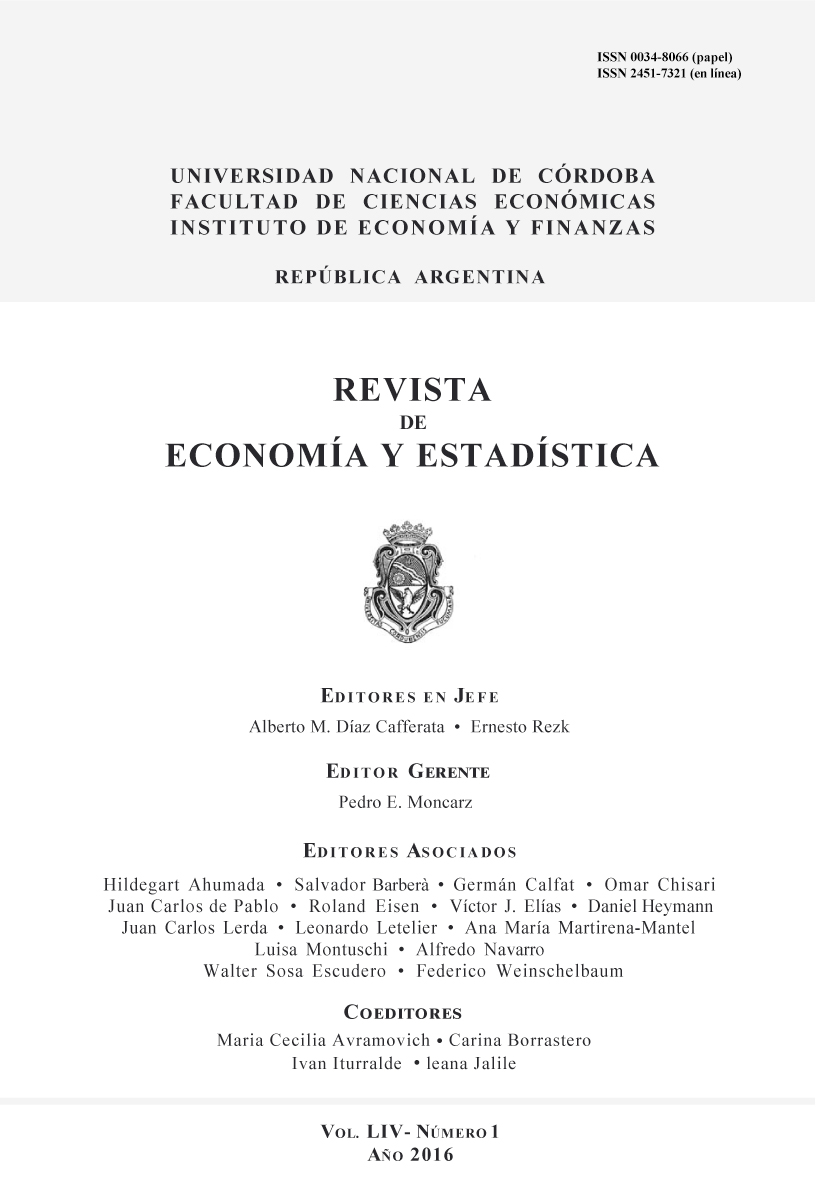Job placement of UNdeC graduates: the effects on income of the mismatches in education and qualifications
DOI:
https://doi.org/10.55444/2451.7321.2016.v54.n1.19430Keywords:
mismatch, education, skills, wages, UNdeCAbstract
In this paper we look at the effects that the mismatches in education and qualifications have on the income of graduates of the Universidad Nacional de Chilecito (UNdeC). We estimate alternative specifications using Ordered Probit and Interval Regression models. Both estimators offer similar results: higher levels of matching in qualifications increase the probability of belonging to higher income intervals; while educational mismatch reduces such probability, although the latter are not statistically significant. Being male and having parents with university education are also positively correlated with a higher likelihood of having higher income.
Downloads
References
Albarrán Pérez, P. (2010). ''Modelos de elección discreta. Material de estudio de Curso de Ingreso''. Universidad de Alicante. Documento disponible en: http://www.rua.ua.es/dspace/bitstream/10045/15809/3/Tema3p.pdf
Allen, J. y van den Velden, R. (2001). "Educational mismatches versus skill mismatches: effects on wages, job satisfaction, and on-the-job search". Oxford Economic Papers, 3, 434-452.
Bauer, T. (2002). "Educational mismatch and wages: a panel analysis". Economics of Education Review, 21, 221-229.
Brynin, M. y Longhi, S. (2009). "Overqualification: Major or minor mismatch?". Economics of Education Review, 28, 114-121.
Cutillo, A. y Di Pietro, G. (2006). "The effects of overeducation on wages in Italy: A bivariate selectivity approach". International Journal of Manpower, 27, 143-168.
Dirección de Vinculación con el Graduado Universitario (2007). "Trayectoria laboral y competencias profesionales de los jóvenes graduados de la UNLP." Universidad Nacional de La Plata. Mimeo.
Dolton, P. y Silles, M. (2008). "The effects of Over-education on Earnings in the Graduate Labour Market". Economics of Education Review, 27, 125-139.
Duncan G. y Hoffman, S. (1981). "The Incidence and Wage Effects of Overeducation". Economics of Education Review, 1, 75-86.
Espínola, B., Acosta, L. y Melis, I. (2006). "Inserción laboral de los graduados de medicina en el nordeste argentino". Facultad de Medicina. Universidad Nacional del Nordeste. Mimeo.
Green, F. y McIntosh, S. (2002). "Is there a genuine underutilization of skills amongst the overqualified?". SKOPE Research Paper 30, Oxford and Warwick Universities.
Lockett, Gil y Alvarez (2000). "Inserción laboral de los graduados de la Facultad de Odontología, en el Nordeste argentino".
Educación superior, mercado de trabajo y práctica profesional, 45, Universidad Nacional del Nordeste. Mimeo.
McGuinness, S. y Bennett, J.(2007). "Overeducation in the graduate labor market: A quantile regression approach". Economics of Education Review, 26, 521-531.
McGuinness, S. (2006). "Overeducation in the Labour Market". Journal of Economics Surveys, 20 (3).
Oficina de Aseguramiento de la Calidad (2014). "Informe sobre la situación laboral de los primeros graduados de la UNRN". Universidad Nacional de Rio Negro. Mimeo.
Sánchez, N. y McGuinness, S. (2011). "Decomposing the Impacts of Overeducation and Overskilling on Earnings and Job Satisfaction: An analysis using REFLEX data". Education Economics. Working Paper 393. Disponible en http.//www.esri.ie/pubs/WP393.pdf
StataCorp (2013). Stata User's Guide: Release 13. College Station, TX: StataCorp.
Verdugo, R. y Verdugo, N. (1989). "The impact of surplus schooling on earnings: some additional findings". Journal of Human Resources, 24, 629-643.
Downloads
Published
Issue
Section
License
Copyright (c) 2016 Marilyn Estefani D’Alessandro

This work is licensed under a Creative Commons Attribution-NonCommercial-NoDerivatives 4.0 International License.
Authors who have publications with this journal agree to the following terms:
Authors retain their copyright and grant the journal the right of first publication of their work, which is simultaneously subject to the Creative Commons Attribution-NonCommercial-NoDerivatives 4.0 International License that allows third parties to share the work provided that its author and first publication in this journal are indicated.
Authors may adopt other non-exclusive licensing arrangements for distribution of the published version of the work (e.g. depositing it in an institutional telematic archive or publishing it in a monographic volume) as long as the initial publication in this journal is indicated.
Authors are allowed and encouraged to disseminate their work via the Internet (e.g. in institutional telematic archives or on their website) before and during the submission process, which can lead to interesting exchanges and increase citations of the published work. (See The Open Access Effect)










